What are the key learning points about nanoparticles?
Nanoparticles are particles which are between 1 and 100 nanometres in size and contain a few hundred atoms.
They have different properties compared to larger particles, this is due to their high surface area to volume ratio.
Nanoparticles have a wide range of potential uses, though there are some concerns their use could have unwanted effects.
What are nanoparticles?
Nanoparticles are particles which are between 1 and 100 nanometres (nm) in size and are made up of a few hundred atomThe smallest particle of an element. We often think of atoms as tiny spheres, but in fact they are made from smaller particles called protons, neutrons and electrons..
One nanometre is 1 × 10-9m or 0.000000001 m.
The properties of nanoparticles are different from those of the same atoms in bulk such as powders, lumps or sheets.
For example, a nanoparticle of gold will behave differently to a lump of gold, even though they both contain the same type of atom.
What is surface area to volume ratio?
The reason that nanoparticles have different properties to bulk materials is that they have a high surface areaThis is the total area a surface of an object occupies. Surface area is usually measured in m² or cm². to volumeThe volume of a three-dimensional shape is a measure of the amount of space or capacity it occupies, eg an average can of fizzy drink has a volume of 330 cm3. ratioA ratio is a way to show the relationship between amounts of one substance compared to another. It is usually written in the form a:b..
A surface area to volume ratio is a measurement of how the surface area of a shape compares to the volume of the same shape.
Smaller structures have a larger surface area to volume ratio than larger ones.
You can demonstrate this mathematically.
When the length of a side of a cube is decreased by a factor of 10 (10 cm to 1cm), the surface area to volume ratioA measurement of how the surface area of a shape compares to the volume of the same shape. increases by a factor of 10 (0.6:1 to 6:1).
Question
Calculate the surface area to volume ratios for a cube with side length 20cm, and a cube with side length 2 cm.
Answer
Why are nanoparticles used in sun cream?
The interesting properties of nanoparticles mean they have a wide range of potential uses.
Nanoparticles are already common in sun creams.
There are some benefits and concerns of using nanoparticles in sun creams.
| Benefits | Concerns |
|---|---|
| Better skin coverage | Nanoparticles may enter cells and cause cell damage |
| Better protection from the sun’s ultraviolet (UV) radiationRays that originate from the sun. Over-exposure to these rays can be harmful for humans. rays | Could wash off skin and cause harm to the environment |
| Colourless once rubbed onto skin | Risks are difficult to determine as nanoparticles have not been in use for very long |
How much do you know about nanoparticles?
More on Unit 1: Structures, trends, chemical reactions, quantitative chemistry and analysis
Find out more by working through a topic
- count5 of 10

- count6 of 10

- count7 of 10

- count8 of 10
